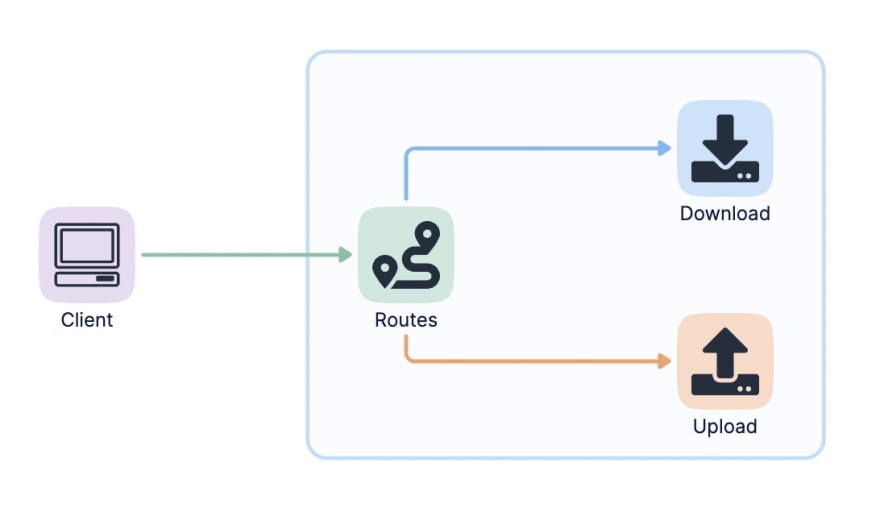Why to write this best practices
- For many startups, we should focus more on delivering application early, and at this time the user base is small and the
QPSis very low, we should use a simpler technical architecture to accelerate the delivery of the application, and this is where the advantages of monoliths come into play. - As I often mentioned in my presentations, while we use monoliths to deliver applications quickly, we also need to consider the future possibilities when developing applications, and we can clearly split modules inside the monolith.
- Many devs asked what's the best practices on developing monoliths with
go-zero.
As go-zero is a widely used microservices framework, which I have precipitated during the complete development of several large projects. We have fully considered the scenario of monolithic service development.
The monolithic architecture using go-zero, as shown in the figure, can also support a large volume of business scale, where Service is a monolithic service of multiple Pods.
I'll share in detail how to use go-zero to quickly develop a monolithic service with multiple modules.
Monolithic example
Let's use an upload and download monolithic service to explain the best practices of go-zero monolithic service development, why use such an example?
The
go-zerocommunity often asks how to defineAPIfiles for uploading files and then usegoctlto generate the code automatically. When I first saw this kind of questions, I thought it was strange, why not use a service likeOSS? I found many scenarios where the user needs to upload excel files, and then the server discards the file after parsing it. One is that the file is small, and the second is that the service is not serving a large amount of users, so we don't need to bring inOSS, which I think is quite reasonable.The
go-zerocommunity also asking how to download files by defining anAPIfile and thengoctlautomatically generating it. The reason why such questions are asked through Go is that there are generally two reasons: one is that the business is just starting, so it's easier to lay out a service to get all things done; the other is that I hope to take the advantages ofgo-zero's built-inJWTauthentication.
This is just an example, no need to go deeper into whether uploading and downloading should be written in Go. So let's see how we can solve such a monolithic service, which we call the file service, with go-zero. The architecture is as follows.
Monolithic implementation
API definition
Devs who have used go-zero know that we provide an API format file to describe the RESTful API, and then we can generate the corresponding code by goctl with one shot, and we only need to fill in the corresponding business logic in the logic file. Let's see how the download and upload services define the API.
Download API definition
The sample requirement is as follows.
- Download a file named
<filename>through the/static/<filename>path - Just return the content of the file directly
We create a file named download.api in the api directory with the following content.
syntax = "v1"
type DownloadRequest {
File string `path: "file"`
}
service file-api {
@handler DownloadHandler
get /static/:file(DownloadRequest)
}
The syntax of zero-api is relatively self-explanatory and means the following.
-
syntax = "v1"means that this is thev1syntax ofzero-api -
type DownloadRequestdefines the request format forDownload -
service file-apidefines the request route forDownload
Upload API definition
The sample requirement is as follows.
- Upload a file via the
/uploadpath - Return the upload status via
json, wherecodecan be used to express a richer scenario thanHTTP code
We create a file called upload.api in the api directory with the following content.
syntax = "v1"
type UploadResponse {
Code int `json: "code"`
}
service file-api {
@handler UploadHandler
post /upload returns (UploadResponse)
}
Explain as follows.
-
syntax = "v1"means this is thezero-apiv1syntax -
type UploadResponsedefines the return format ofUpload -
service file-apidefines the request route forUpload
Here comes the problem
We have defined the Download and Upload services, but how can we put them into a service?
I don't know if you have noticed some details.
- either
DownloadorUpload, we prefixed therequestandresponsedata definition, and did not use directly such asRequestorResponse - we define
serviceindownload.apiandupload.apiwithfile-apias theservice name, notdownload-apiandupload-apirespectively
The purpose of this is to automatically generate the corresponding Go code when we put the two services into the monolithic service. Let's see how to merge Download and Upload together~
Defining the monolithic service API
For simplicity reasons, goctl only supports accepting a single API file as a parameter, the issue of accepting multiple API files is not discussed here and may be supported later if we figure out a simple and efficient solution.
We create a new file.api file in the api directory with the following content.
syntax = "v1"
import "download.api"
import "upload.api"
This way we import both Download and Upload services like #include in C/C++. But there are a few things to keep in mind.
- the defined structs cannot be renamed
- the
service namemust be the same in all files
The outermost
APIfile can also contain part of the sameservicedefinition, but we recommend to keep it symmetrical, unless theseAPIs really belong to the parent level, e.g. the same logical level asDownloadandUpload, then they should not be defined infile.api.
At this point, we have the following file structure.
.
└── api
├── download.api
├── file.api
└── upload.api
Generating monolithic service
Now that we have the API interface defined, the next step is pretty straightforward for go-zero (of course, defining the API is pretty straightforward, isn't it?). Let's use goctl to generate the monolithic service code.
$ goctl api go -api api/file.api -dir .
Let's take a look at the generated file structure.
.
├── api
│ ├── download.api
│ ├── file.api
│ └── upload.api
├── etc
│ └── file-api.yaml
├── file.go
├─ go.mod
├── go.sum
└── internal
├─ config
│ └─ config.go
├─ handler
│ ├── downloadhandler.go
│ ├── routes.go
│ └── uploadhandler.go
├─ logic
│ ├── downloadlogic.go
│ └── uploadlogic.go
├── svc
│ └── servicecontext.go
└─ types
└─ types.go
Let's explain the layout of the project by directory.
-
apidirectory: theAPIinterface description file we defined earlier, no need to talk much -
etcdirectory: this is for theyamlconfiguration files, all configuration items can be written in thefile-api.yamlfile -
file.go: the file where themainfunction is located, with the same name asservice, removed-apisuffix -
internal/configdirectory: the configuration definition of the service -
internal/handlerdirectory: thehandlerimplementation of the routes defined in theAPIfile -
internal/logicdirectory: used to put the business processing logic corresponding to each route, the reason for the distinction betweenhandlerandlogicis to minimize the dependency of the business processing part, to isolateHTTP requestsfrom the logic processing code, and to facilitate the subsequent splitting intoRPC serviceas needed -
internal/svcdirectory: used to define the dependencies for business logic processing, we can create the dependent resources inmainand pass them tohandlerandlogicviaServiceContext -
internal/typesdirectory: defines theAPIrequest and response data structure
Let's not change anything, let's run it and see how it works.
$ go run file.go -f etc/file-api.yaml
Starting server at 0.0.0.0:8888...
Implementing the business logic
Next we need to implement the relevant business logic, but the logic here is really just for demonstration purposes, so don't pay too much attention to the implementation details, just understand that we should write the business logic in the logic layer.
The following things are done here.
- Add the
Pathsetting in the configuration item to place the uploaded files, and by default I wrote the current directory, because it is an example, as follows.
type Config struct {
RestConf
// New
Path string `json:",default=." `
}
- Adjusted the request body size limit as follows.
Name: file-api
Host: localhost
Port: 8888
# New
MaxBytes: 1073741824
- Since
Downloadneeds to write the file to the client, we passedResponseWriterasio.Writerto thelogiclayer, and the modified code is as follows
func (l *DownloadLogic) Download(req *types.DownloadRequest) error {
logx.Infof("download %s", req.File)
body, err := ioutil.ReadFile(req.File)
if err ! = nil {
return err
}
n, err := l.writer.Write(body)
if err ! = nil {
return err
}
if n < len(body) {
return io.ErrClosedPipe
}
return nil
}
- Since
Uploadneeds to read the files uploaded by the user, we passhttp.Requestto thelogiclayer and the modified code is as follows.
func (l *UploadLogic) Upload() (resp *types.UploadResponse, err error) {
l.r.ParseMultipartForm(maxFileSize)
file, handler, err := l.r.FormFile("myFile")
if err ! = nil {
return nil, err
}
defer file.Close()
logx.Infof("upload file: %+v, file size: %d, MIME header: %+v",
handler.Filename, handler.Size, handler.Header)
tempFile, err := os.Create(path.Join(l.svcCtx.Config.Path, handler.Filename))
if err ! = nil {
return nil, err
}
defer tempFile.Close()
io.Copy(tempFile, file)
return &types.UploadResponse{
Code: 0,
}, nil
}
Full code: https://github.com/zeromicro/zero-examples/tree/main/monolithic
We can start the file monolithic service by running the following command.
$ go run file.go -f etc/file-api.yaml
The Download service can be verified with curl:
$ curl -i "http://localhost:8888/static/file.go"
HTTP/1.1 200 OK
Traceparent: 00-831431c47d162b4decfb6b30fb232556-dd3b383feb1f13a9-00
Date: Mon, 25 Apr 2022 01:50:58 GMT
Content-Length: 584
Content-Type: text/plain; charset=utf-8
...
The sample repository contains upload.html, the browser can open this file to try the Upload service.
Summary of monolithic development
Let me summarize the complete process of developing a monolithic service with go-zero as follows.
- define the
APIfiles for each submodule, e.g.download.apiandupload.api - define the general
APIfile, e.g.file.api. Use it toimporttheAPIfiles of each submodule defined in step 1 - generate the monolithic service framework code via the
goctl api gocommand - add and adjust the configuration to implement the business logic of the corresponding submodule
In addition, goctl can generate CRUD and cache code according to SQL in one shot, which can help you develop monolithic services more quickly.
Project address
https://github.com/zeromicro/go-zero
Welcome to use go-zero and star to support us!









Oldest comments (3)
Whats your's tool you use for draw architecture ?
onemodel.app/
Thank a lot.